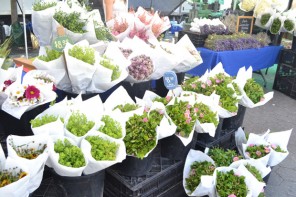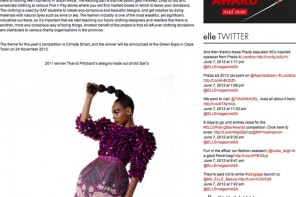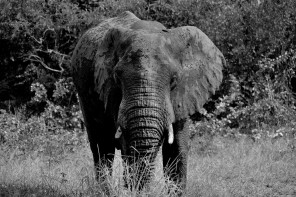Written by: Wilma den Hartigh
Thanks to South African consumers, the demand for over-exploited fish stocks is declining.
Increasing consumer pressure on seafood retailers to stock sustainably harvested fish and support eco-friendly fishing methods have caused stocks of species such as kingklip to show signs of recovery.
The Southern African Sustainable Seafood Initiative (SASSI) was launched six years ago to involve the entire seafood supply chain, including consumers, in creating a sustainable seafood industry. Today this initiative has proven to be a highly successful South African consumer campaign. The ocean has often been viewed as an “infinite resource”, but buy-in from the public is helping to correct this perception.
Janine Basson from the Sustainable Fisheries Programme (SFP): Fisher and Consumer Outreach, says the SASSI programme has been so successful to date because consumers feel empowered. Their choices can drive positive change towards the recovery of fish stocks.
“Consumers are given the opportunity to make informed choices when choosing which seafood to buy and eat. People want to be part of the solution to overfishing, and SASSI is a tool that allows them to do that,” Basson says.
There are other seafood campaigns globally that are doing similar work. However, Basson says the major difference is that other international programmes do not partner with seafood industry players, whereas the World Wide Fund for Nature (WWF) South Africa is partnering with industry. This is a key strength of the programme.
Finding solutions together
A number of programmes are jointly finding solutions to the problem of overfishing and declining fish stocks. The SFP forms part of the WWF Sanlam Living Waters partnership, an initiative to promote marine conservation in South Africa.
The SFP works across the seafood supply chain to address ecosystem overexploitation. It contributes to two of the partnership’s targets for the marine sector – firstly, to apply an ecosystem approach to fisheries in South Africa and reduce the impacts of destructive fishing practices to acceptable levels. Its other goal is to restore at least half of over-exploited fish stocks to sustainably managed levels, while still maintaining or improving the state of other stocks.
The SFP aims to meet these targets through activities that focus on how fish are caught and traded. The Responsible Fisheries Programme works directly with the fishing industry and resource management and addresses how fish are caught. SASSI focuses on the trading aspect, which involves retailers, restaurants, chefs and consumers.
Consumers are asking the right questions
Dr Samantha Petersen, project manager of the SFP, said in a statement that consumers must continue asking restaurants and retailers if they serve or sell sustainably harvested fish and seafood.
Some fishing and seafood farming methods pose more harm to the environment than others. For instance, Basson says, line- or pole-caught methods are relatively selective and don’t kill unintended species such as seabirds and sharks. Although some forms of seafood farming can reduce pressure on overexploited wild stocks, this is only the case if wild fish don’t have to be fed to farmed fish, or if the production method doesn’t further degrade the environment.
Consumers must not hesitate to ask in-depth questions about seafood and find out what they are buying or eating, where it comes from and how it was caught. Research indicates that positive changes at sea have predominantly resulted from consumer queries.
“One consumer who asks questions about the sustainability of their seafood is likely to have a bigger influence than 100 who simply make a green choice without telling the restaurant or retailer why,” Basson says.
Major success has also been achieved with SASSI’s progressive consumer tools. The SASSI Consumer Pocket Guide, originally drafted in 2005, uses a three-level colour classification to rate fish. Green indicates best choice while orange suggests caution and red means the species is illegal or classified as a “no sale species”.
Certain species such as tuna were categorised in the green group, but this did not take the fishing method into account. The original red group only included the species that are prohibited from being sold by law.
The new and updated SASSI list includes a revision of a number of species included on the original list. The new red group lists unsustainable species along with those that are illegal to sell in South Africa.
Basson says the original list excluded important imported and aquaculture species, but the updated version includes a selection of these species.
“This was becoming an increasingly pressing need due to the growing South African aquaculture industry,” she says.
The SASSI programme’s prominent online presence has also made it easy for consumers to participate. Consumers can obtain the most up-to-date information at any time on the SASSI website, FishMS and mobi site. The FishMS service allows consumers to access the SASSI seafood database from any mobile phone. Consumers can send a text message to the number 079 499 8795 to find out whether a particular species is on the red, orange or green list.
According to Petersen the response from wholesalers and retailers to consumer pressure has also been encouraging. A growing number of participants at this end of the value chain are actively involved with the SFP. Quarterly assessments are carried out with each partner to evaluate their seafood procurement process and raise awareness amongst staff.
The programme is working with 11 of the biggest seafood suppliers in South Africa (such as Aquatic Foods and Fish On Line), the large retailers (Pick n Pay, Woolworths, Spar) and popular restaurant chains such as John Dory’s and Ocean Basket. Offshore and inshore commercial industry players, such as I&J and Sea Harvest, are also involved.
Fish stocks are recovering
Petersen said in a statement that kingklip stocks almost collapsed a few years ago. However, because of consumer pressure many restaurants stopped offering it on the menu and retailers no longer kept it in stock. Catch limits were also introduced and the kingklip spawning site near Port Elizabeth in the Eastern Cape was placed under protection. “I really hope to see kingklip on the green list one day soon.”
Basson says that some of South Africa’s linefish species are also showing signs of recovery. For example, red roman, a member of the seabream family, is a popular linefish species that is endemic to Southern Africa. It is a reef-associated species with a relatively narrow distribution from Namibia to the Eastern Cape.
She says it is a slow growth species – a 40cm fish could be as old as 40 years. They achieve late sexual maturity and change sex from female to male as they mature. These factors make them highly vulnerable to overfishing.
Red roman stocks are in urgent need of rebuilding as they have almost disappeared in some areas such as False Bay on the southern Cape coast.
However, she says that there is evidence of recovery within Marine Protected Areas (MPA) along the coast. Research has shown a 90% increase in catches of red roman within the
Goukamma MPA. Goukamma is situated on the Garden Route on the Cape South Coast. The exclusion of fishing boats from Goukamma has also been beneficial.
“Although much remains to be done to get the red roman stock back to its former glory, this still indicates the tremendous value of MPAs in rebuilding the breeding stock of important over-exploited linefish species,” says Basson.
SA consumers are more environment aware
Consumers are becoming more aware of issues affecting the environment.
“South African consumers are one of the main reasons why SASSI has been so successful and why we have seen some of our fish species recover,” Basson says.
Another success story is that of the South African hake trawl fishery. Significant progress has been made in the management of the hake resource, as a result of both Marine Stewardship Council certification and consumer pressure. If consumers continue to ask questions, it will have major positive impacts for the entire seafood industry.
Source: www.mediaclubsouthafrica.com
The liveeco team





